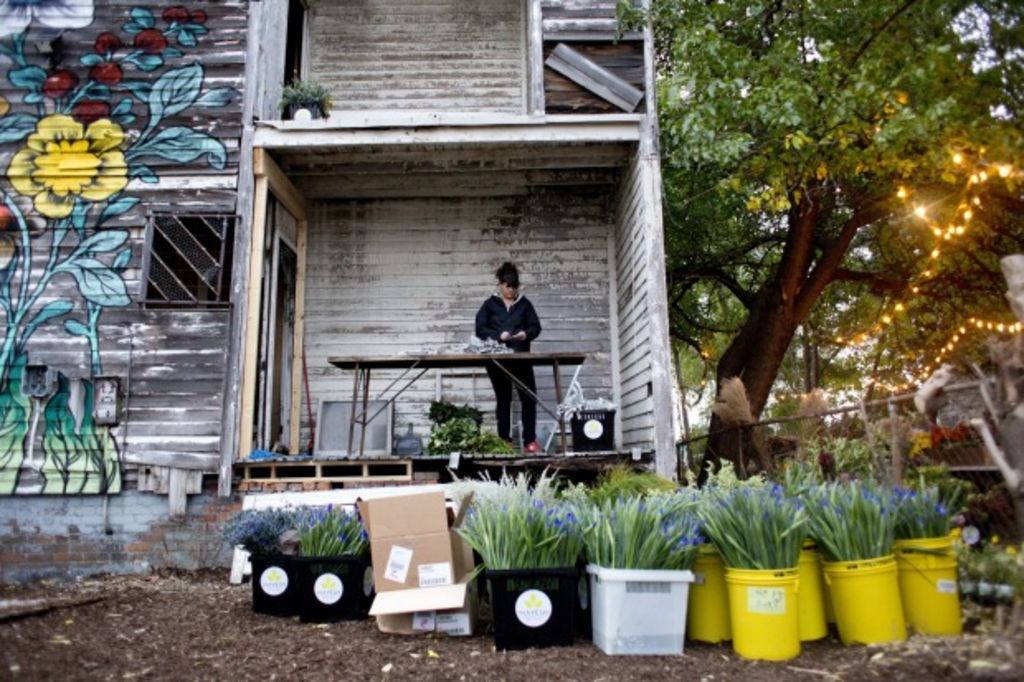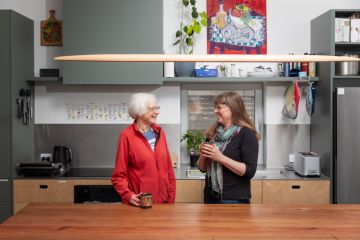A florist's vision turns an abandoned house into a piece of art

Eleven months ago, a derelict house here that is now filled with 36,000 flowers contained far grimmer things. A dead dog. Jammed toilets, untouched for years. Broken glass from beer bottles and shattered windows.
Twelve thousand pounds of rubbish had to be hauled out before Lisa Waud, a florist who bought the duplex at auction for $250, could see what kind of canvas she had purchased.
The house remains a structural wreck, but its atmosphere has been transformed. This weekend, some 2000 visitors will tour Flower House, an art installation Waud and more than three dozen floral collaborators from around the country created on the site. Their goal is to cast a new light on the Detroit metropolitan area’s infamous blight, and on their own trade.
The dwelling’s empty rooms with their peeling wallpaper, exposed wooden beams and a few items of abandoned furniture left intact have been turned into a series of still-life tableaus. All of the plants and flowers filling them are American-grown, a rarity in an industry that imports a majority of its wares from Colombia and elsewhere.
Waud is the owner of Pot & Box, a floral design business. Like most independent florists, she earns her living almost entirely from weddings and work for corporate clients, but she lights up when she talks about the beauty that plants can add to daily life.
The inspiration for Flower House struck in 2012, when she saw images from that season’s Christian Dior couture show, held in a Parisian mansion filled with flowers in a rainbow of colours.
“It was stunning, and I knew immediately that I wanted to do that but living in Detroit, I pictured it in an abandoned house,” she said. “I’m trying to rebrand abandoned houses as a resource.”
Her vision began to become real last November, when she paid $500 at auction, sight unseen, for the house that was to become Flower House and its next-door neighbour. As she told other designers about her plan, seeking ideas and volunteers, what started as an artistic daydream became a formal project with budgets, permits, complicated logistics and deadlines.
Waud estimated that she would need to raise $150,000 to cover the installation’s floral costs, but when she contacted her usual wholesalers, the California Cut Flower Commission, Mayesh and Nordlie, all three offered to donate their flowers. The 36 other florists designing rooms in Flower House were equally eager to contribute materials and their time.
Sally Vander Wyst, the owner of Milwaukee Flower Co, heard about the project through a podcast and immediately contacted Waud to volunteer. She is designing a kitchen, covering the decaying cupboards and a salvaged table with artichokes, moss, hanging vines, ferns and a profusion of dahlias, gladiolas and foxglove.
“Our concept is post-apocalyptic spooky,” she said. “We want it to look like the world ended and nature took things back within seconds.”
To make Flower House stable enough for her installation, Waud hired Reclaim Detroit, a non-profit that specialises in deconstruction, a more expensive but environmentally minded alternative to demolition. Reclaim Detroit’s crews recycle and salvage whatever they can, reselling the materials to woodworkers and artisans.
Like Waud, Craig Varterian, the executive director of Reclaim Detroit, views the area’s derelict buildings as an economic resource. “These structures range from horrible to an absolute disaster, but there’s still worth in them in terms of fixtures and lumber,” he said. “Pre-1930s, there’s a different type of wood. It has real value, and it doesn’t exist anymore.”
Reclaim Detroit’s workers cleared the rubbish from Waud’s house and stripped away its layers of filth. Mixed in with the debris, they found some hints of its past life. A thick stack of calendar pages tacked to a wall ends with January 1999 displayed on top. Photos of the former owners, identified by a neighbour, turned up in the attic. On a bedroom wall, Waud hung a china plate with a message that seemed tailor-made for her project: “This Is My House And I’ll Do As I Darn Please.”
Flower House will be opened to ticketed visitors from Friday until Sunday. When the installation is finished, Reclaim Detroit’s crew will take down the house, leaving an empty field. The wood will be repurposed into new objects like tables, guitars and cutting boards.
“These materials will carry on the story of Flower House in a tangible way,” said Jeremy Haines, the Reclaim Detroit employee who co-ordinated the project. “It creates a legacy that people will have in their hands.”
The house itself is not salvageable. Like so many of the derelict Detroit homes that sell for rock-bottom prices, this one would cost more to rehabilitate than it is ever likely to be worth. A construction engineer whom Waud spoke with estimated the repair costs at $1 million. Paying this year’s property taxes on Flower House and its neighbour cost Waud three times what she spent to actually buy them.
When the lot is cleared, Waud plans to turn it into a seasonal farm to help supply flowers like peonies and dahlias for her business.
Susan McLeary, the owner of Passionflower in Ann Arbor, Michigan, and one of Flower House’s designers, said that was one aspect that drew her to the venture. Urban agriculture is gaining attention, but few people think of flowers as a cash crop.
“Per square foot, flowers are one of the more profitable things you can do with dirt,” she said. “This might be an interesting idea to get into the consciousness, that you can be an urban flower farmer and bring money into your community.”
Other cities have experimented with that idea, most notably Baltimore, which recently commissioned a study on the economic viability of turning some of the city’s 14,000 vacant lots into leased land for small-scale flower farms.
Those in the industry say they see rising demand for locally sourced flowers. Vander Wyst, who specialises in domestic plants, said an increasing number of her clients specifically seek her out for that reason.
“We’re obsessed with the farmer, the maker, the organic grower, but for the longest time, flowers somehow got skipped in that dialogue,” said Debra Prinzing, a writer and lecturer who spearheads what she calls Slow Flowers, a parallel to the Slow Food movement.
Last year, she created a directory of farmers and florists who specialise in American-grown foliage. It now has 600 members, a few dozen of whom are involved in Flower House.
Waud said she hoped Flower House would inspire those who encounter it to think more critically about where the flowers they buy come from and about the diversity of American blooms. She was also excited about the pure fun of coating an entire site in flowers by the truckload.
“Wedding work is fun, translating the vision into flowers, but to have this kind of creative freedom is really rare for florists,” she said. “The sheer scale of it is incredible, and I’m blown away by the community that came together for this. I’m going to be in happy, emotional tears the whole weekend.”
McLeary, who recently toured the empty house to plan her room’s installation – succulents will be a prominent feature – said she couldn’t wait to see the structure brought back for its last, ephemeral bit of life.
“It’s a beautiful ruin,” she said. “It’s charming, kind of scary and eerie, and beautiful in a dark way. To step into it is going to be surreal, and unforgettable.”
The New York Times
We recommend
States
Capital Cities
Capital Cities - Rentals
Popular Areas
Allhomes
More
- © 2025, CoStar Group Inc.







